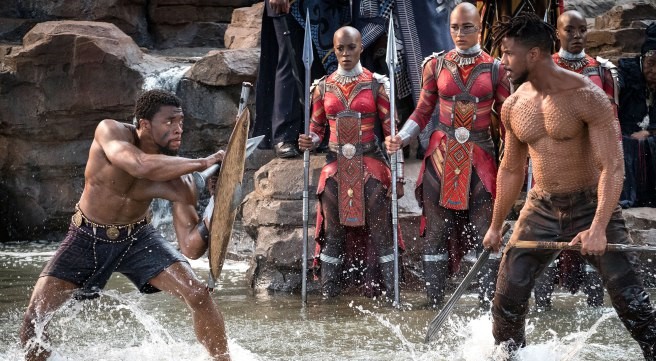With the new Marvel Black Panther film on the horizon, some may wonder what it is about. Others may be curious as to why it shares a name with the political group of the 60s and 70s.
Consider this a simple crash course to impress all your friends after you catch it in the theater.
The Black Panther comic book character pre-dates the controversial political organization by mere months.
 The Black Panther Party was officially formed in October 1966. The comic character was introduced in Fantastic Four #52 in April 1966 (cover date July) and was the first black superhero from a mainstream comic book company. That character opened the door for the creation for other black superheroes.
The Black Panther Party was officially formed in October 1966. The comic character was introduced in Fantastic Four #52 in April 1966 (cover date July) and was the first black superhero from a mainstream comic book company. That character opened the door for the creation for other black superheroes.
Black Panther, whose real name is King T’Challa, was created by comic book icons Stan Lee and Jack Kirby, as part of their legendary run that consists of Fantastic Four #1-102. It was the follow-up to two of the most beloved stories in Fantastic Four’s history – the “Galactus/Silver Surfer” saga and “This Man, This Monster.”
Black Panther is often portrayed as a type of King Solomon – wise and fiercely dedicated to the well-being of his people. He is also fiercely isolationist, as are his subjects. He is a physicist with a genius intellect, super strength, and enhanced senses.
T’Challa is the ruler of Wakanda, a fictional African nation that has rejected invaders (both African and European) for centuries. Residents dress in tribal garb and worship an ancient Panther god.
The nation is also considered one of the most technologically advanced in the world. The technologies they developed even surpassed Star Trek in some cases. (No space travel, though.) That impressed Reed “Mr. Fantastic” Richards, the leader of the Fantastic Four, whose character is considered to be the smartest man in the Marvel Universe.
In one story, the Fantastic Four helps T’Challa stop Ulysses Klaw from stealing the nation’s vibranium, a fictional metal with incredible strength that absorbs and redirects sound vibration. It is also the primary basis for most of Wakanda’s economy and technology.
T’Challa also had a very personal vendetta. Klaw killed his father, T’Chaka, the previous Black Panther and king.
T’Challa, or the Black Panther, became a recurring character in the Fantastic Four for decades, before eventually becoming a temporary leader in 2007.
Around the time he married the X-Men’s Storm, one of the most popular women in comics, who served with him. The union would end in divorce.
Before joining the Fantastic Four he was a member of the Avengers, which he joined in the late 1960s. As part of the Avengers his alter ago, or secret identity, was Luke Charles, an inner city public school teacher.
During that time he briefly became the Black Leopard so as not to be confused with the political party, which had begun to get negative news coverage.
That was an interesting change since most comic book creators at the time were former protestors and hippies, who may have been sympathetic to the Black Panther’s cause.
For example, in one comic when the Hulk was put on trial, he was made up to look like Black Panther Party co-founder Bobby Seale, with his mouth covered.
As an Avenger or a member of the Fantastic Four, he is often the character they turn to when solving a science-related problem. While he is a loyal member of those groups, his ultimate allegiance is first to his people.
His popularity in the Avengers led to ongoing stories in Jungle Action, and eventually his own comic.
However, those solo stories did not make it to the end of the 1970s, despite Jack Kirby’s involvement. The Black Panther did return in the 1980s in a highly praised story in Marvel Comics Presents, where the Panther had to rescue his mother from South Africa. It was especially vaunted for its realistic depictions of apartheid.

That was not the first time the character was be used for political stories. In the 1970s the Panther is pitted against The Klan.
The Black Panther series, which was part of the Marvel Knights line, started in the late 1990s, is considered the best run in the character’s history. It also played a key role in returning Marvel, which was coming back from bankruptcy, to its lost glory. The series was written by former Marvel editor Christopher Priest and was the first long run written by a black man.
Next up was the 2000’s run, written by former Black Entertainment Television (BET) President Reggie Hudlin. He stripped off much of the depth and character work done by Priest. In many readers’ eyes, it was an inferior version of what was considered a masterpiece that took advantage of the character’s unique attributes.
This series contained lines about the Panther like “a black man who can’t be bought with money and a white woman,” which offended many. The series also lacked compelling stories. It did, however, act as the basis for a short-lived animated series on Black Entertainment Television (BET).
For all the mythology and stories surrounding the character, the Panther’s most important roll was opening the door to black characters in mainstream comics. The Falcon (Marvel’s first African American superhero), Luke Cage, Misty Knight, Storm, Black Lightning, Static and even supporting character like Spider-Man’s Joe Robertson and Batman’s Luscious Fox, were made possible by this one character.
The Black Panther movie may seem shiny and new to many who have not read the comics, but it is really just another part of a long and proud tradition.
Lead photo by Matt Kennedy. Courtesy of Marvel Studios


